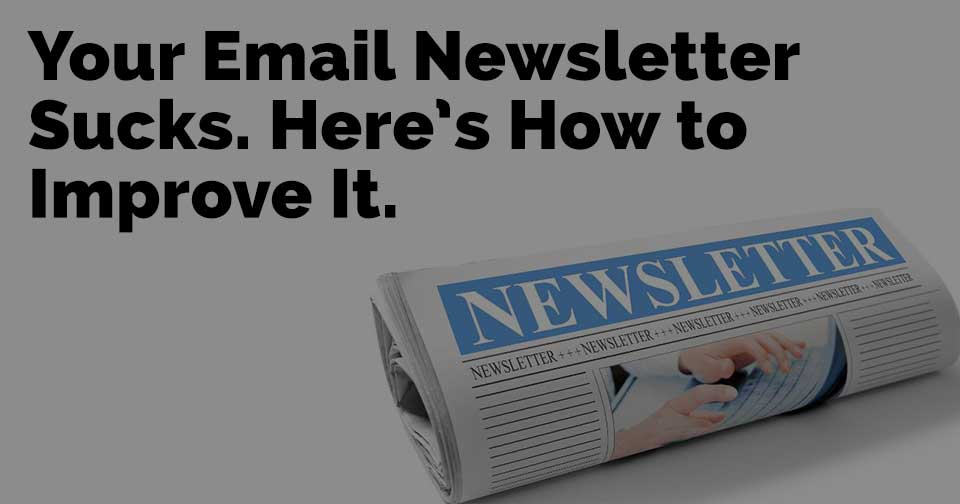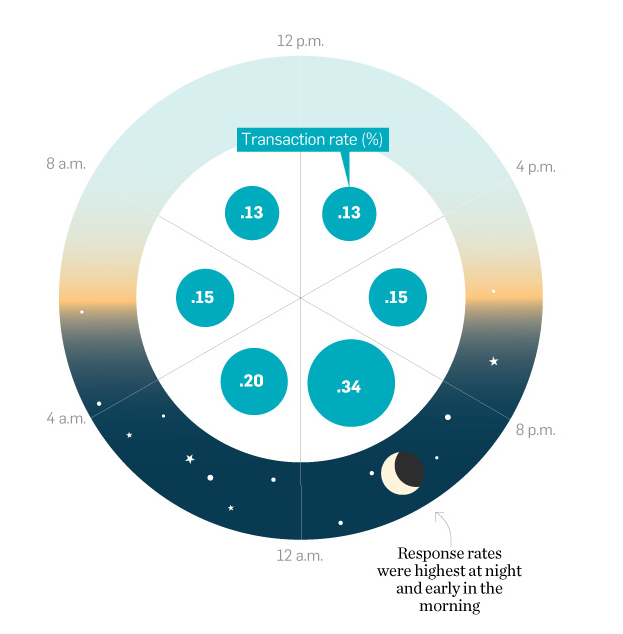
A great email newsletter can be like an ATM to a company. A bad email newsletter can cause sleepless nights for a CMO and angry meetings for a CEO. Chances are, your newsletter falls into the second category. Sprucing your email newsletter up to not just get more subscribers but to get more quality subscribers is a noble venture and one worth at least reading this article for.
How do you know if your email newsletter sucks?
— Your engagement rates are low. See here to see what your industry average is. This should go without saying, but if you have a lot of email subscribers who don’t really do anything, then your newsletter can use some reworking. These people care enough to be signed up (so they don’t unsubscribe) but not enough to click through.
— You keep losing email subscribers on net. You will have unsubscribes. Oh well. Get used to it. When you have people unsubscribe from your newsletter who don’t really read it, this is a good thing. The problem occurs when you have more people unsubscribing from your newsletter than you have subscribing.
— You don’t send an email newsletter… “But we’re a B2B construction company!” “But who would read an email newsletter about a nail salon?” Stop it. Your customers. That’s who would read an email newsletter about any industry. In fact, according to HubSpot, the industries with the highest open rates are some of the industries in which you would not expect an email newsletter, like construction, law, real estate, and the arts. Your email newsletter is a way to get directly in front of your customers and get the extra touches that you need in your industry to make an impact on them.
— You never get replies from followers. A good email newsletter engages followers and gives them more than it takes from them (again, it is a way to get a touch). This means that a good email newsletter should be prepared to get replies from subscribers who have questions, enjoy the newsletter, or want to contribute to the discussion. Replies are a good thing. Encourage them.
— Your email newsletter looks like a bulletin. The email template generator is the worst thing that has happened since email content since spam. These tools make it too easy to just throw a few links into an email and send them out with no commentary, no flow, and no narrative. Your email newsletter doesn’t have to look fancy (in fact, some of the best-performing email newsletters look like plain text HTML emails), but don’t throw it into the coffin of bulletin templates.
— You dread putting it together. If you don’t enjoy putting your email newsletter together, the chances that your readers will enjoy opening it are low. You can refactor your content to make it enjoyable.
We took a look at some of the best daily email newsletters out there and distilled what makes them successful. Model these newsletters to supercharge your own.
1. Add Value
The cardinal rule of newsletter creation is to add value outside of announcements or offers you may bring to the table. When your newsletter has a reputation among readers for adding value, they are more likely to open the newsletter regardless of whether or not you are running some kind of promotion.
A good way to add value is to have core stories or core reports that you focus on bringing value through explaining concepts or ideas that are current events or captured by discussions within your specific target community.
Here’s an example from today’s copy of TheSkimm:
 This newsletter adds value by explicating, in long-form, a complex idea that the subscribers of something like TheSkimm will find value in. In this case, that’s the complex idea of migrants going to Europe from Libya.
This newsletter adds value by explicating, in long-form, a complex idea that the subscribers of something like TheSkimm will find value in. In this case, that’s the complex idea of migrants going to Europe from Libya.
If you are a marketing company, you can emulate this by breaking down trends in different marketing sectors, like the move towards branded contentand what it means for companies. Take a trend in which your audience is interested and explicate that. Make it something that they can extract value from quickly or could spend an hour reading and thinking about.
This is how you get people to open your newsletter. You don’t need to provide them with special offers or sale items specific to your company in every email. When you do decide to bring out these offers, by continually adding value, you increase the odds that your readers will actually open the newsletter and click through.
2. Send it More Often
The email newsletter noob thinks that you only send an email newsletter when you have news you want to share, like announcements, sales, and specials.
This is the wrong approach.
Again, think of your email newsletter as a way of building a relationship with your followers and gaining opportunities for them to go from satisfied customers to raving fans. If you think of your newsletter as something that may annoy or distract them, then you will be less likely to send quality newsletters more often.
Instead, reframe how you view your newsletter as something that adds value to their lives and something to which they should be looking forward. Send it regularly — every weekday performs surprisingly well — so that they know when to expect it and can add it to their reading for the day.
3. Send it…Less Often
Once you go from sending your newsletter once or twice a month to sending it every weekday, it’s easy to get carried away with excitement at the results. You’ll want to send a newsletter every single day.
Beware of this trap.
 Turns out, people prefer to get regular content but not to be inundated when they are trying to take time off or spend time with their families. Keep your newsletters to weekdays (or late Sunday night also performs well), regular, and not more than once a day, unless you have a real reason to send more than one a day.
Turns out, people prefer to get regular content but not to be inundated when they are trying to take time off or spend time with their families. Keep your newsletters to weekdays (or late Sunday night also performs well), regular, and not more than once a day, unless you have a real reason to send more than one a day.
You don’t want your newsletter to be so scarce that people forget about it, but you don’t want it to be so available that nobody feels compelled to open it in the first place.
4. Make It Shareable
 The best way to grow your email list is through your current subscribers. Make your content short and shareable with a high viral coefficient. You can achieve something like this by occasionally running email competitions and giveaways. Give your readers a reason to share the newsletter. A pithy quotation (with a social share button underneath of it), an interesting fact, or an infographic are all powerful tools to drive the reader to share.
The best way to grow your email list is through your current subscribers. Make your content short and shareable with a high viral coefficient. You can achieve something like this by occasionally running email competitions and giveaways. Give your readers a reason to share the newsletter. A pithy quotation (with a social share button underneath of it), an interesting fact, or an infographic are all powerful tools to drive the reader to share.
If you are using Mailchimp, you can actually track which of your subscribers are the most likely to open your newsletters and you can target them for special promotions. The Results Junkies newsletter does this well. You can also track how many times somebody has forwarded your newsletter on to other potential subscribers and who subscribed because of the newsletter being forwarded by a subscriber.
At The Mission, they ran a book giveaway focusing on our subscribers who forwarded our newsletter and shared it on social media with promising results. We grew our subscribers day-over-day and continued the momentum even after the giveaway had finished.
5. Make It Shorter
A long newsletter is intimidating.
It’s also difficult to track.
If your newsletter is too long and your readers choose not to scroll to the bottom, you may lose valuable info about your open rate. The tracking pixel that helps your email client track open rates often appears towards the bottom of the email, meaning that longer emails will result in the tracking pixel being cut off and a dramatic drop in your open rates.
Try sending out a few email newsletters that are shorter and see if your open rate increases. If you have to cut content, simply move more content beyond the break, forcing your subscribers to click back to your site if they want to keep reading, anyway.
6. Make It Simpler
Some of the best email newsletters look like simple HTML. Ramit Sethi’s high-performing newsletter is one such example.
If you feel like your formatting clutters up your newsletter and keeps it from conveying the value it brings to subscribers, try simplifying. Simple HTML and one or two pictures will suffice in most cases.
If your newsletter is built around a personal brand, plain text (or a plain-text lookalike) is a powerful choice for you. Readers will get the feeling that you actually sat down at a keyboard and wrote for them (especially if you then send them a reply when they message you).
7. Send It Later
Common sense would tell you that the best time to send an email newsletter is either during the day (that’s when you pay your marketing people, right? And when people are at work, so you would think they would want to receive work-related emails then, right?) or at midday when people are more likely to check their email before heading off to lunch.
The reality is that you should send your email newsletter in the evening.
 People like to check their email before they go to bed. Take advantage of this and send them something when they have more time to poke around their inbox than during the rushed commute to and from work.
People like to check their email before they go to bed. Take advantage of this and send them something when they have more time to poke around their inbox than during the rushed commute to and from work.
Most email clients give you the opportunity to send to all of your subscribers according to their time zone, so you don’t have to worry about hitting your west coast clients at 5 PM because you wanted to hit your east coast clients at 8 PM.
Follow these few, simple changes and your email newsletter takes on a life of its own. Ignore them at your own peril.
(article via www.TheMission.co)




